The 2012 MacBook Air (11 & 13-inch) Review
by Anand Lal Shimpi on July 16, 2012 12:53 PM EST- Posted in
- Apple
- Mac
- MacBook Air
- Laptops
- Notebooks
The Display
The MacBook Air is really Apple's mass-market notebook, and as such it's not going to be the target for a Retina Display upgrade, at least not this year. While technically feasible, my guess is a lack of supply kept a rMBA out of the cards for this year. There's also the matter of maintaining its thin profile and battery life in pursuit of a retina display.
The MacBook Air display continues to be good, and better than most, but no where near what the rMBP delivers and actually a step behind what the competition in the PC space has been cooking up.
If there was one clear trend at Computex this year it's towards IPS 1080p displays in Windows 8 notebooks. ASUS actually pre-empted all of the exciting announcements (rMBP included) with its Zenbook Prime, complete with 11 and 13-inch 1080p IPS displays. As the MacBook Air retains its TN display, for the first time we can actually say that ASUS' Ultrabook offers better viewing angles than the Air. The difference is quite noticeable:
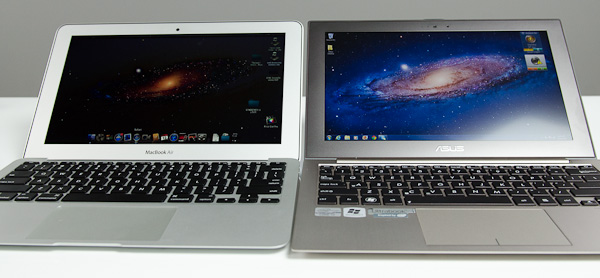
2012 MacBook Air (left) vs. 2012 ASUS Zenbook Prime (right)
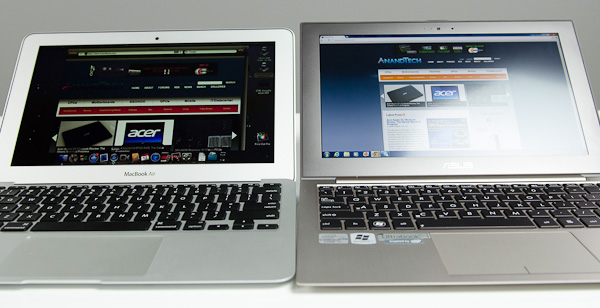
2012 MacBook Air (left) vs. 2012 ASUS Zenbook Prime (right)
ASUS also enjoys a resolution advantage, but it's not really high enough to make good use of integer DPI scaling (at 2x you get a UI sized for a 960 x 540 display). You get sharpness, and additional desktop area, but not the total package you get with the rMBP. There's no denying that what ASUS has done is better, it's just not perfect. And as Apple has shown us in the past, it's not fond of stopgap solutions.
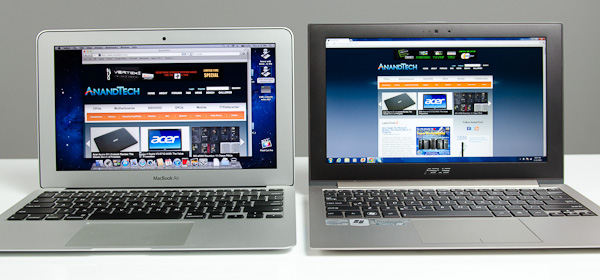
2012 MacBook Air (left) vs. 2012 ASUS Zenbook Prime (right)
Brightness, black levels, contrast, color accuracy and gamut haven't changed over the past year. The MacBook Air's panel remains one of the best non-IPS solutions on the market. The problem is that consumer insistence higher quality displays has pushed Apple's competitors to finally deliver more than TN at MacBook Air price points. Sooner rather than later, Apple will have to respond.
The Panel Lottery
Unlike in previous years, there appears to be three manufacturers supplying panels for the 2012 MacBook Air. LG Philips and Samsung return from before, but AUO now joins the fray. It's quite possible that Apple's volumes have grown large enough to justify adding a third supplier - a trend we may see increase in the future, and across more component categories.
As always, you can try to find out what panel is used in your MacBook Air by executing the following command in an OS X Terminal window:
ioreg -lw0 | grep IODisplayEDID | sed "/[^<]*</s///" | xxd -p -r | strings -6
The output will look something like this:

As long as Apple hasn't masked the data, the first line should be the part number of your display panel. The first one or two characters will tell you the manufacturer: LP for LG Philips, LT for Samsung and B for AUO. Anecdotally, LG and Samsung seem to be the most prevalent. In my personal experience with six 13-inch 2012 MacBook Airs and three 11-inch MacBook Airs, the breakdown was as follows:
13-inch $1499 - Samsung
13-inch $1499 - Samsung
13-inch $1499 - Samsung
13-inch $1499 - Samsung
13-inch $1499 - Samsung
13-inch $2199 - LG
11-inch $1099 - AUO
11-inch $1099 - AUO
11-inch $999 - Samsung
A thread over on Macrumors places the Samsung/LG split much closer to 50/50, however it's not clear if there's a higher incidence of LG panels in BTO or non-default configurations. We'd need many more samples to really get an idea for how all of this shapes up, so don't put too much faith in the results from my experience.
Apple does its best to ensure that all three panels deliver comparable performance, however there are differences. Let's first start with the numbers:
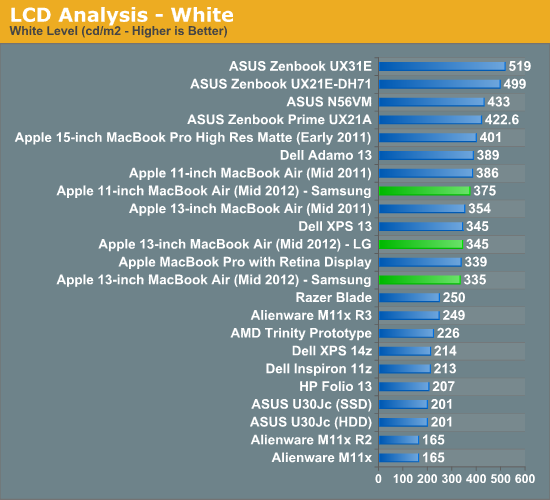
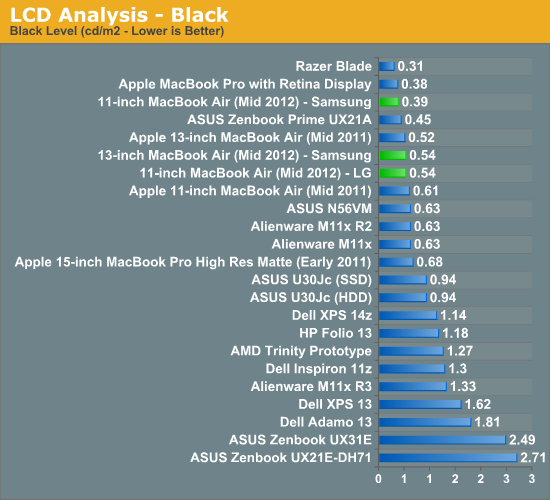
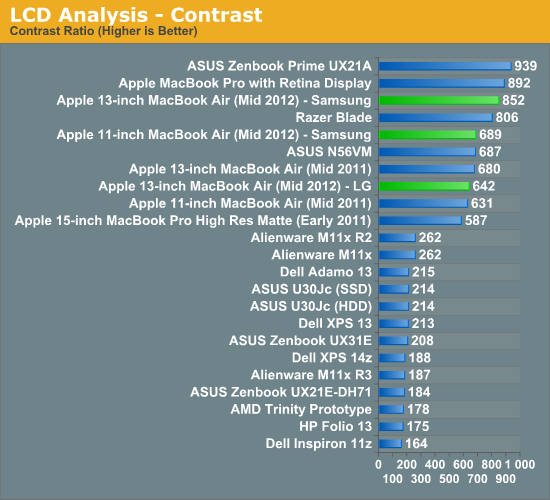
The 13-inch LG panel delivers tangibly worse black levels than the Samsung alternative. There's even a pretty dramatic difference in black levels between even the 11 and 13-inch Samsung panels. It's also possible that there's panel to panel variation at play here that would result in this sort of a difference.
The LG panel is a bit brighter, which helps it reach a decent contrast ratio but the 13-inch Samsung panel's low black levels give it an advantage. Interestingly enough, the 13-inch LG sample performed very similarly to the 11-inch Samsung. I really do wonder how much of this difference is just normal variance between panels.
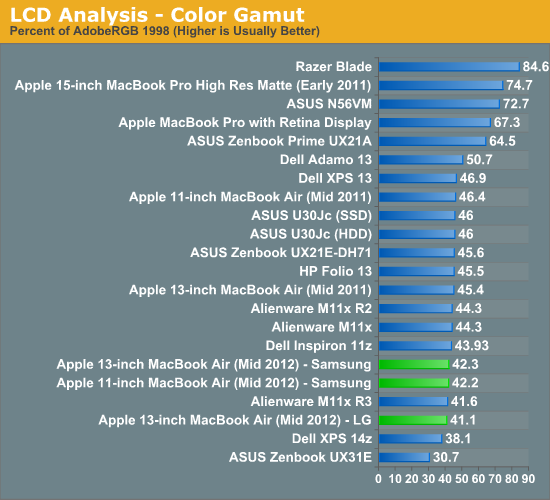
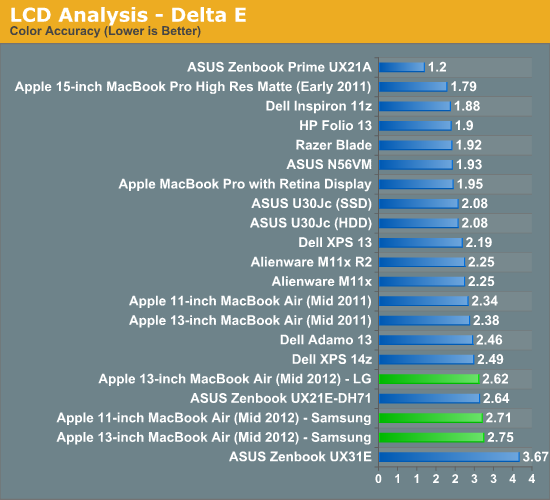
Color accuracy is slightly better on the LG panel, although it's not beyond the noticeable threshold. Color gamut is comparable between the displays.
Independently, neither the Samsung or LG panels is particularly bad to look at. These are still TN panels so you get poor vertical viewing angles, but the quality is still better than the cheaper TNs we often see used in less expensive notebooks. It's when you compare the two or you're used to one that you can really tell a difference: the Samsung panel, particularly when displaying black text on a white background, looks better than the LG.
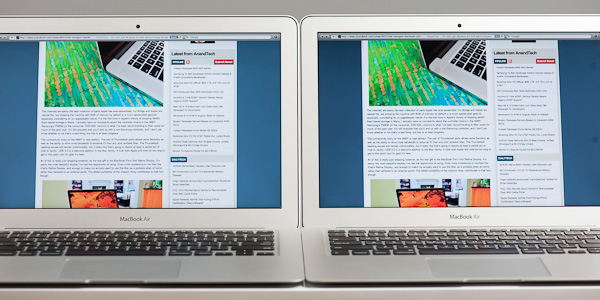
13-inch LG LP133WP1-TJA3 panel (left) vs. Samsung LTH133BT01A03 panel (right)
I had some friends over and tossed them a pair of 13-inch MBAs. One had the LG panel and one had the Samsung panel. They used the MBAs and swapped after a short while. Almost instantaneously they could tell the difference between the panels. Everyone significantly favored the Samsung.
I was actually a bit surprised how quickly they noticed the difference. With these type of things I always assume I'm just more sensitive than most, but in this case the difference was noticeable enough to pick out. Everyone added (and I agreed) that the difference was most pronounced because they were able to switch between two. In a vacuum each one seemed fine.
I tried my best to capture the difference between the two panels on camera. The easiest way to describe the difference is text on the Samsung panel just looks darker (mouse over the panel name in the table below):
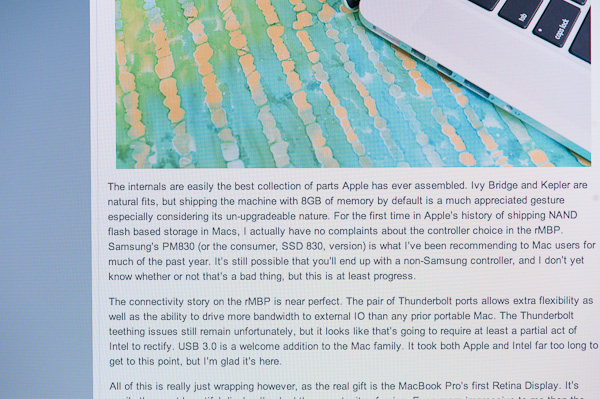
| LG LP133WP1-TJA3 | Samsung LTH133BT01A03 |
| original | original |
Just like last time, I believe the two panels behave differently in how they react to off-center viewing angles but I couldn't really capture the slight differences on camera. Although I didn't have an AUO equipped MBA on hand, the one I saw in an Apple store looked closer to the LG than the Samsung.
The good news is after a calibration pass using Color Eyes Display Pro, the difference between the two is significantly reduced - to the point where I can no longer tell the two apart:
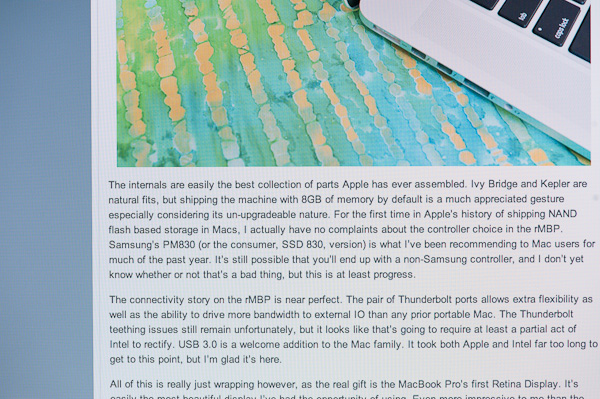
| LG LP133WP1-TJA3 | Samsung LTH133BT01A03 |
| original | original |
The obvious problem with this solution is you need access to a decent colorimeter or spectrophotometer and calibration software. There are some color profiles floating around the web that may help (I've uploaded mine for the LG here, Samsung here) but every panel is going to be at least somewhat different so this is still not perfect.
Subjectively, I'm fine with the LG panel, although I do like the look of the Samsung better. Both are a bit of a disappointment compared to what you get from the Retina Display in the MacBook Pro however. It's just presently what you give up for portability and cost.
To Make a Retina
The thing about the MacBook Air is that it's already quite minimized on the inside. The vast majority of the chassis is occupied by a battery, and there's no traditional HDD or optical drive to remove for additional space. Apple can't simply toss a much higher resolution panel on the system and call it a day, at least not without a tangible reduction in battery life.

13-inch MacBook Air (Mid 2012) - iFixit
Apple had to give the MacBook Pro with Retina Display a 95Wh battery (up from 77.5Wh) just to deliver similar battery life to the regular MacBook Pro. The higher resolution display requires a brighter backlight to push light through the panel and maintain comparable brightness levels.
The motherboard itself can stand to lose a single chip (the PCH) with the transition to Haswell, but that's not going to give us a ton of space either.
In the short term Apple could opt for a slightly thicker chassis (similar to what happened in the 3rd gen iPad) to accommodate a larger battery. Eventually the hope is that panel efficiency will increase to the point where we won't need significantly brighter backlights.


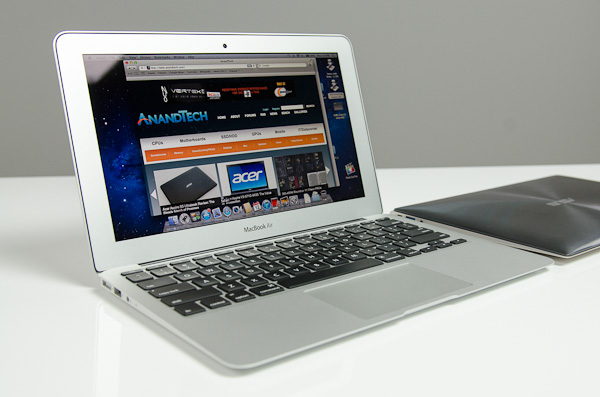








190 Comments
View All Comments
TechKnow12 - Saturday, September 22, 2012 - link
I too was planning on buying an SD card to use as extra storage. I just bought a 128Gb MBA rather than 256Gb as it was $300 cheaper. Firstly, I wasn't aware of the deep sleep issue with the SD card however I discovered the same issue with leaving a USB drive connected. I'll investigate your two solutions below. Thanks for posting that info!Lastly, I did some research on SD card performance/speed. Something to keep in mind for anyone who is also planning to do this, the cheaper ones only have a speed of around 30MB/s and the faster, more expensive ones with a speed of 95MB/s. When you compare the cost of the faster cards to the option of buying a MBA with the 256Gb's, the best option would have been to buy the 256Gb MBA.
The following is a short speed comparison of SD cards vs. USB vs. MBA SSD:
SD 30MB/s = 240mbps
SD 45MB/s = 360mbps
SD 65MB/s = 520mbps
SD 95MB/s = 760mbps
USB 2.0 (60MB/s) = 480mbps
USB 3.0 (625MB/s) = 5000mbps
MacBook Air 2012 SSD: writes at 364MB/sec, reads at 461MB/sec
In speed order:
SD 30MB/s = 240mbps
SD 45MB/s = 360mbps
* MacBook Air 2012 SSD: writes at 364MB/sec, reads at 461MB/sec
USB 2.0 (60MB/s) = 480mbps
SD 60MB/s = 480mbps
SD 95MB/s = 760mbps
USB 3.0 (625MB/s) = 5000mbps
So for best performance (read/write speeds) I would go with the 60MB/s SD card however it is expensive. Around $300 for 128Gb. Thus it probably would have been better to buy the MBA 256Gb version. Or you could go for a Sandisk 128Gb 45MB/s card for $170. Slightly slower then MBA's SSD but should be good enough for music and video files (I think). Would be good to find out from anyone using an SD card for storage what they think.
:)
TechKnow12 - Saturday, September 22, 2012 - link
Sorry, made an error with the SD 65MB/s in the first list. Should have read:SD 60MB/s = 480mbps not SD 65MB/s = 520mbps
:)
phillyry - Thursday, March 28, 2013 - link
Dude. The ssd speeds and sizes are both in MB/s and GB, not Mb/s and Gb. So, the internal storage (SSD) is running at 360-460MB/s and your SD cards are capped out at 95MB/s.400MB/s is clearly better than 95MB/s. No need for conversions, as they're both already in MB/s.
The Sandisk 45 MB/s SD card is an ORDER OF MAGNITUDE SLOWER (10x) than the SSD in the MBA.
You would only buy an SD for either transferring files or getting a little extra (non-critical) storage capacity.
Not only will the drive be slower than a typical mechanical hard drive - only the 95MB/s ones will pass a basic 80MB/s HDD - it will be around 1/10 to 1/5 the speed of the SSDs in the 2012 MBA.
cookiezulu - Wednesday, August 1, 2012 - link
In the meantime I have found (via another user - thanks Ken Ng) that there are too apps on Mac App store for this purpose (unmounting external devices when laptop goes to sleep and remounting them automatically when laptop is taken out of sleep):- AutoEJECT (by DragonBTV developer)
- Jetisson (by StClair Software)
TechKnow12 - Saturday, September 22, 2012 - link
Well, I got really fed up with the performance of my WIndows 7 based netbook and the lack of good and abundant support from the netbook manufacturers website. Apple has that many forums that you can always get some sort of assistance somewhere. As for Windows 7 it is less intuitive than Windows XP which for me personally resulted in a less than desirable user experience. My netbook had a multitouch touch pad but not as advanced as MBA.I was rather impressed with the performance and quality of the MBA that I decided to take the plunge and get one. Now this is my first ever experience with Mac and OSX. It took me a little bit of acclimatising however OSX is so much easier to use, more intuitive. The experience so far has been awesome. There are lots of hidden tricks with the touch pad which are awesome too.
There are too many PROs to list. As for CONs there are just a couple which I've encountered. One that is easily fixable is the auto adjusting screen brightness. On a cloudy day where ambient brightness can change constantly as clouds move by, the brightness fluctuates constantly to match. Not very pleasant for the eyes. Simple fix is to turn off this function. The other is web page loading where Safari just hangs and does nothing until you re click on the link or cancel the page load then hit refresh. Doesnt seem to be a problem with Firefox.
Battery life is good and as stated. Cut a couple of hours off that if you're streaming Youtube clips or playing music. But again, as it goes with battery life, it is all subjective to how you use the MBA.
So will I ever go back to Windows? No.
I've been running Windows 8 RC on a spare PC and it is less intuitive than Win 7. It's actually quite horrible. Not something I would want to use permanently.
I think more people are going to be making the switch to Mac in future.
TechKnow12 - Monday, October 1, 2012 - link
Heh hehhh! I'm going back on my word or rather on my statement above regarding Windows. :pSince actually having tried out Bootcamp and installing Windows 7, I can now run Win 7 natively and run Win only programs. Win 7 runs really well on MBA. Battery life is about the same. Voice control works well with the inbuilt microphone.
I love how Bootcamp has given me dual boot functionality as I originally thought Bootcamp was akin to VMWare.
It's virtually like having two ultrabooks in one. One Mac and one Windows.
Unfortunately Safari swipe gestures (back & fwd) aren't supported under Windows.
And OSX doesn't have voice control to control everything like Win 7 does. But I guess that will come soon as Siri develops and hopefully makes it to OSX. :)
ald - Friday, November 16, 2012 - link
I was wondering about the calibration profile provided for the LG display of Macbook air, to me it seems like it makes greys a little brown and whites a little yellow, and when you look at the display from side it has a weird green tint. Does anyone else have the same problem. I have downloaded this profile from http://osxdaily.com/2011/10/30/how-to-check-for-an... which seems to do a much better job.tdtran1025 - Tuesday, November 27, 2012 - link
The time is right for Apple to deploy their brew of ARM-based SoC in Airs, basing on the performance of the latest iPad. It would make sense for Apple to indulge this form factor to increase their gross margin, and for those who despise touch typing. I am sure Apple will find ways to increase the performance of the current ARM processors to match that of low end Intel C2D within 18 months. All that power saving may push battery performance to beyond 5 hours in the Airs, something we can all go for.phillyry - Thursday, March 28, 2013 - link
Are you crazy?Arm is nowhere near where it needs to be to run OS X.
DPsocial - Wednesday, January 9, 2013 - link
This computer is absolutely perfect for college http://bit.ly/MacBook_Air_DPS My roommate used this computer through college, very light and perfect for going to class. Highly recommended.